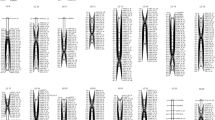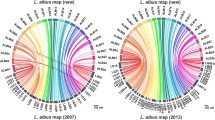Abstract
We report the first gene-based linkage map of Lupinus angustifolius (narrow-leafed lupin) and its comparison to the partially sequenced genome of Medicago truncatula. The map comprises 382 loci in 20 major linkage groups, two triplets, three pairs and 11 unlinked loci and is 1,846 cM in length. The map was generated from the segregation of 163 RFLP markers, 135 gene-based PCR markers, 75 AFLP and 4 AFLP-derived SCAR markers in a mapping population of 93 recombinant inbred lines, derived from a cross between domesticated and wild-type parents. This enabled the mapping of five major genes controlling key domestication traits in L. angustifolius. Using marker sequence data, the L. angustifolius genetic map was compared to the partially completed M. truncatula genome sequence. We found evidence of conserved synteny in some regions of the genome despite the wide evolutionary distance between these legume species. We also found new evidence of widespread duplication within the L. angustifolius genome.






Similar content being viewed by others
References
Atkins CA, Smith PMC, Gupta S, Jones MGK, Caligari PDS (1998) Genetics, Cytology and Biotechnology. In: Gladstones JS, Atkins CA, Hamblin J (eds) Lupins as crop plants: biology, production and utilization. CAB International, London, pp 67–92
Bennett MD, Smith JB, Heslopharrison JS (1982) Nuclear-DNA Amounts in Angiosperms. Proc R Soc Lond B Biol Sci 216:179–199
Bhardwaj HL (2002) Evaluation of lupin as a new food/feed crop in the Mid-Atlantic region. In: Janick J, Whipkey A (eds) Trends in new crops and new uses. ASHS Press, Aleksandria, pp 115–119
Boersma JG, Pallotta M, Li CD, Buirchell BJ, Sivasithamparam K, Yang HA (2005) Construction of a genetic linkage map using MFLP and identification of molecular markers linked to domestication genes in narrow-leafed lupin (Lupinus angustifolius L.). Cell Mol Biol Lett 10:331–344
Brien SJ, Cowling WA, Potter RH, Jones RAC, Jones MGK (1999) A molecular marker for early maturity (Ku) and marker-assisted breeding of Lupinus angustifolius. In: Santen Ev, Wink M, Weissmann S, Romer P (eds) 9th International lupin conference– Lupin, an ancient crop for the new millennium. International Lupin Asssociation, Klink/Muritz, Germany, pp 115–117
Carruthers K, Prithiviraj B, Fe Q, Cloutier D, Martin RC, Smith DL (2000) Intercropping of corn with soybean, lupin and forages: silage yield and quality. J Agron Crop Sci 185:177–185
Choi HK, Kim D, Uhm T, Limpens E, Lim H, Mun JH, Kalo P, Penmetsa RV, Seres A, Kulikova O, Roe BA, Bisseling T, Kiss GB, Cook DR (2004a) A sequence-based genetic map of Medicago truncatula and comparison of marker colinearity with M. sativa. Genetics 166:1463–1502
Choi HK, Mun JH, Kim DJ, Zhu HY, Baek JM, Mudge J, Roe B, Ellis N, Doyle J, Kiss GB, Young ND, Cook DR (2004b) Estimating genome conservation between crop and model legume species. Proc Natl Acad Sci U S A 101:15289–15294
Cowling WA (1999) Pedigrees and characteristics of narrow-leafed lupin cultivars released in Australia from 1967 to 1998. Bulletin 4365, Agriculture Western Australia, Perth
Cowling WA, Huyghe C, Swiecicki W (1998) Lupin breeding. In: Gladstones JS, Atkins CA, Hamblin J (eds) Lupins as crop plants: biology, production and utilization. CAB International, London, pp 93–120
Devos KM (2005) Updating the ’Crop circle’. Curr Opin Plant Biol 8:155–162
Edwards AC, van Barneveld RJ (1998) Lupins for livestock and fish. In: Gladstones JS, Atkins C, Hamblin J (eds) Lupins as Crop plants: biology, production and utilisation. CAB International, London, pp 385–411
Gladstones JS (1967) Selection for economic characters in Lupinus angustifolius L. and L. digitatus Forsk. I. Non-shattering pods. Aust J Exp Agric Anim Husbandry 7:360–366
Gladstones JS (1977) The narrow-leafed lupin in Western Australia (Lupinus angustifolius L.). Western Australian Department of Agriculture Bulletin 3990
Gladstones JS, Crosbie GB (1978) Lupin wild types introduced into Western Australia to 1973. Technical Bulletin No. 43. Department of Agriculture Western Australia, South Perth, Australia
Gupta S, Buirchell BJ, Cowling WA (1996) Interspecific reproductive barriers and genomic similarity among the rough-seeded Lupinus species. Plant Breed 115:123–127
Hajdera I, Siwinska D, Hasterok R, Maluszynska J (2003) Molecular cytogenetic analysis of genome structure in Lupinus angustifolius and Lupinus cosentinii. Theor Appl Genet 107:988–996
Konieczny A, Ausubel FM (1993) A procedure for mapping arabidopsis mutations using codominant ecotype-specific PCR-based markers. Plant J 4:403–410
Lagercrantz U, Lydiate DJ (1996) Comparative genome mapping in Brassica. Genetics 144:1903–1910
Lavin M, Herendeen PS, Wojciechowki MF (2005) Evolutionary rates analysis of leguminosae implicates a rapid diversification of lineages during the tertiary. Syst Biol 54:575–594
Lukens L, Zou F, Lydiate D, Parkin I, Osborn T (2003) Comparison of a Brassica oleracea genetic map with the genome of Arabidopsis thaliana. Genetics 164:359–372
Lyons LA, Laughlin TF, Copeland NG, Jenkins NA, Womack JE, Obrien SJ (1997) Comparative anchor tagged sequences (CATS) for integrative mapping of mammalian genomes. Nat Genet 15:47–56
Majoros WH, Pertea M, Antonescu C, Salzberg SL (2003) GlimmerM, exonomy and unveil: three ab initio eukaryotic genefinders. Nucleic Acids Res 31:3601–3604
Manly KF, Cudmore RH, Meer JM (2001) Map manager QTX, cross-platform software for genetic mapping. Mamm Genome 12:930–932
Mikolajczyk J (1966) Genetic studies in Lupinus angustifolius. Part III. Inheritance of the alkaloid content, seed hardness and length of the growing season in blue lupin. Genet Pol 7:181–196
Moolhuijzen PM, Cakir M, Macgregor A, Smith C, Hunter A, Schibeci D, Francki M, Jones M, Appels R, Bellgard M (2006) LegumeDB bioinformatics resource: Comparative genomic analysis and novel cross-genera marker identification in Lupin and pasture legume species. Genome (in press)
Moore G, Devos KM, Wang Z, Gale MD (1995) Cereal genome evolution—grasses, line up and form a circle. Curr Biol 5:737–739
Naganowska B, Kaczmarek A (2005) Repetitive DNA sequences in cytogenetic studies of Lupinus genome. Monograph, 11th international Lupin conference, “Mexico, where Old and New World lupins meet”, Guadalajara, Mexico
Naganowska B, Zielinska A (2002) Physical mapping of 18S-25S rDNA and 5S rDNA in Lupinus via fluorescent in situ hybridization. Cell Mol Biol Lett 7:665–670
Naganowska B, Zielinska A (2004) Localisation of rDNA in the Lupinus genome during the cell cycle. J Appl Genet 45(2), 2004, pp 189–193 45:189–193
Naganowska B, Wolko B, Sliwinska E, Kaczmarek Z (2003) Nuclear DNA content variation and species relationships in the genus Lupinus (Fabaceae). Ann Bot 92:349–355
Nelson P (1994) The development of the lupin industry in Western Australia and its role in sustainable farming systems. In: Neves Martins JM, Beirão da Costa L (eds) Advances in Lupin Research. ISA Press, Lisbon, pp 565–576
Nelson MN, Lydiate D (2006) New evidence from Sinapis alba L. for ancestral triplication in a crucifer genome. Genome (in press)
Petterson DS (1998) Composition and food uses of lupins. In: Gladstones JS, Atkins CA, Hamblin J (eds) Lupins as crop plants: biology, production and utilization. CAB International, London, pp 353–384
Pfeil BE, Schlueter JA, Shoemaker RC, Doyle JJ (2005) Placing paleopolyploidy in relation to taxon divergence: A phylogenetic analysis in legumes using 39 gene families. Syst Biol 54:441–454
Reeves DW (1991) Experiences and prospects for lupin in the South and Southeast. Prospects for Lupin in North America, Symposium Proceedings, University of Minnesota, St. Paul, pp 23–30
Rinehart T (2004) AFLP analysis using GeneMapper software and an Excel macro that aligns and converts output to binary. Biotechniques 37:186–188
Sharpe AG, Parkin IAP, Keith DJ, Lydiate DJ (1995) Frequent nonreciprocal translocations in the amphidiploid genome of oilseed rape (Brassica napus). Genome 38:1112–1121
Shoemaker RC, Polzin K, Labate J, Specht J, Brummer EC, Olson T, Young N, Concibido V, Wilcox J, Tamulonis JP, Kochert G, Boerma HR (1996) Genome duplication in soybean (Glycine subgenus soja). Genetics 144:329–338
Varshney RK, Sigmund R, Borner A, Korzun V, Stein N, Sorrells ME, Langridge P, Graner A (2005) Interspecific transferability and comparative mapping of barley EST-SSR markers in wheat, rye and rice. Plant Sci 168:195–202
Vos P, Hogers R, Bleeker M, Reijans M, van de Lee T, Hornes M, Frijters A, Pot J, Peleman J, Kuiper M, Zabeau M (1995) AFLP: A new technique for DNA fingerprinting. Nucleic Acids Res 23:4407–4414
Wilkins RJ, Jones R (2000) Alternative home grown protein sources for ruminants in the United Kingdom. Anim Feed Sci Technol 85:23–32
Wolko B, Weeden N (1989) Estimation of Lupinus genome polyploidy on the basis of isozymic loci number. Genet Pol 30:165–171
Wolko B, Weeden NF (1994) Linkage map of isozyme and RAPD markers for the Lupinus angustifolius L. In: Neves Martins JM, Beirão da Costa L (eds) Advances in lupin research. ISA Press, Lisbon, pp 42–49
Yan HH, Mudge J, Kim DJ, Shoemaker RC, Cook DR, Young ND (2004) Comparative physical mapping reveals features of microsynteny between Glycine max, Medicago truncatula, and Arabidopsis thaliana. Genome 47:141–155
Acknowledgements
The mapping population originated from research begun by WAC during his employment at the Department of Agriculture Western Australia. Subsequent development of RILs, phenotyping, mapping of markers and comparative mapping was supported by Grains Research and Development Council (GRDC) UWA372, the Australian Research Council (ARC) LP0454871, and the Polish State Committee for Scientifc Research. Salaries of MNN and WAC are supported by a grant from the Export Grains Centre Ltd. The development of Lupinus spp.-derived cross-species marker primers were supported by GRDC UMU105 and ARC DP0559547. We thank Bevan Buirchell for providing seed for the RIL population, Sarah Brien for early assistance in the project and Michael Francki, Craig Atkins and Penny Smith for providing the L. angustifolius cDNA library.
Author information
Authors and Affiliations
Corresponding author
Additional information
Communicated by J. S. Heslop-Harrison
Electronic supplementary material
Rights and permissions
About this article
Cite this article
Nelson, M.N., Phan, H.T.T., Ellwood, S.R. et al. The first gene-based map of Lupinus angustifolius L.-location of domestication genes and conserved synteny with Medicago truncatula . Theor Appl Genet 113, 225–238 (2006). https://doi.org/10.1007/s00122-006-0288-0
Received:
Accepted:
Published:
Issue Date:
DOI: https://doi.org/10.1007/s00122-006-0288-0




